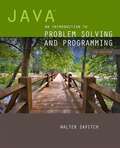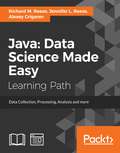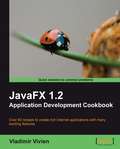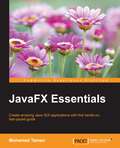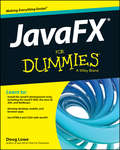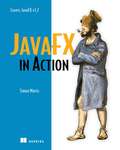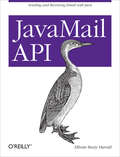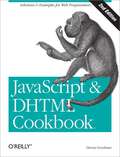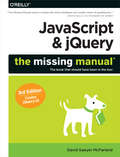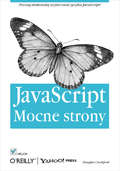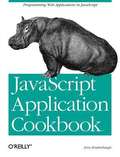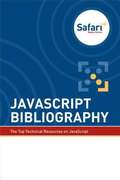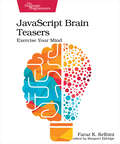- Table View
- List View
Java: An Eventful Approach
by Kim B. Bruce Andrea Pohoreckyj Danyluk Thomas P. MurtaghJava, an object-oriented language with many standard libraries, offers both complexities and opportunities. This introductory book makes use of a new approach to understanding programming in Java. Provides an objects-first approach to programming. Introduces object-oriented graphics and writing methods early in the book. Motivates readers to use event-driven programming. Reinforces the importance of understanding several threads. For anyone interested in the programming language of Java.
Java: An Introduction to Problem Solving and Programming (Seventh Edition)
by Walter SavitchAn introduction to programming using the Java computer programming language.
Java: Boost your application’s performance with the new features of Java 9
by Mayur RamgirOptimize the powerful techniques of Java 9 to boost your application's performanceKey Features Tackle all kinds of performance-related issues and streamline your development Dive into the new features of Java 9 Implement highly efficient and reliable codes with the help of new APIs of Java Embedded with assessments that will help you revise the concepts you have learned in this bookBook DescriptionJava 9 which is one of the most popular application development languages. The latest released version Java 9 comes with a host of new features and new APIs with lots of ready to use components to build efficient and scalable applications. Streams, parallel and asynchronous processing, multithreading, JSON support, reactive programming, and microservices comprise the hallmark of modern programming and are now fully integrated into the JDK. This book focuses on providing quick, practical solutions to enhance your application's performance. You will explore the new features, APIs, and various tools added in Java 9 that help to speed up the development process. You will learn about jshell, Ahead-of-Time (AOT) compilation, and the basic threads related topics including sizing and synchronization. You will also explore various strategies for building microservices including container-less, self-contained, and in-container. This book is ideal for developers who would like to build reliable and high-performance applications with Java. This book is embedded with useful assessments that will help you revise the concepts you have learned in this book.What you will learn Familiarize with modular development and its impact on performance Learn various string-related performance improvements, including compact string and modify string concatenation Explore various underlying compiler improvements, such as tiered attribution and Ahead-of-Time (AOT) compilation Learn security manager improvements Understand enhancements in graphics rasterizers Use of command-line tools to speed up application development Learn how to implement multithreading and reactive programming Build microservices in Java 9 Implement APIs to improve application codeWho this book is forThis book is targeted at developers who would like to build reliable and high-performance applications with Java.
Java: Data Science Made Easy
by Richard M. Reese Jennifer L. Reese Alexey GrigorevData collection, processing, analysis, and more About This Book • Your entry ticket to the world of data science with the stability and power of Java • Explore, analyse, and visualize your data effectively using easy-to-follow examples • A highly practical course covering a broad set of topics - from the basics of Machine Learning to Deep Learning and Big Data frameworks. Who This Book Is For This course is meant for Java developers who are comfortable developing applications in Java, and now want to enter the world of data science or wish to build intelligent applications. Aspiring data scientists with some understanding of the Java programming language will also find this book to be very helpful. If you are willing to build efficient data science applications and bring them in the enterprise environment without changing your existing Java stack, this book is for you! What You Will Learn • Understand the key concepts of data science • Explore the data science ecosystem available in Java • Work with the Java APIs and techniques used to perform efficient data analysis • Find out how to approach different machine learning problems with Java • Process unstructured information such as natural language text or images, and create your own searc • Learn how to build deep neural networks with DeepLearning4j • Build data science applications that scale and process large amounts of data • Deploy data science models to production and evaluate their performance In Detail Data science is concerned with extracting knowledge and insights from a wide variety of data sources to analyse patterns or predict future behaviour. It draws from a wide array of disciplines including statistics, computer science, mathematics, machine learning, and data mining. In this course, we cover the basic as well as advanced data science concepts and how they are implemented using the popular Java tools and libraries.The course starts with an introduction of data science, followed by the basic data science tasks of data collection, data cleaning, data analysis, and data visualization. This is followed by a discussion of statistical techniques and more advanced topics including machine learning, neural networks, and deep learning. You will examine the major categories of data analysis including text, visual, and audio data, followed by a discussion of resources that support parallel implementation. Throughout this course, the chapters will illustrate a challenging data science problem, and then go on to present a comprehensive, Java-based solution to tackle that problem. You will cover a wide range of topics – from classification and regression, to dimensionality reduction and clustering, deep learning and working with Big Data. Finally, you will see the different ways to deploy the model and evaluate it in production settings. By the end of this course, you will be up and running with various facets of data science using Java, in no time at all. This course contains premium content from two of our recently published popular titles: • Java for Data Science • Mastering Java for Data Science Style and approach This course follows a tutorial approach, providing examples of each of the concepts covered. With a step-by-step instructional style, this book covers various facets of data science and will get you up and running quickly.
Java: Der Sprachkurs für Einsteiger und Individualisten (Für Dummies Ser.)
by Arnold V. WillemerJava programmieren lernen auf die etwas andere Art: Wenn Sie sich eine verständliche Einführung wünschen, liegen Sie mit diesem Buch genau richtig, es kann aber noch viel mehr! Witzige Beispiele, knifflige Aufgaben und unzählige schräge Anekdoten von Programmier-Original Arnold Willemer sorgen dafür, dass Sie gar nicht anders können, als Java zu lernen. Von der ersten Schleife über die Datenbank-Entwicklung bis zu Ihrer eigenen Android-App werden Sie alles lernen, was Sie brauchen - und haben auch noch Spaß dabei!
Java: Unearthing the Excellence in Java
by Jim WaldoWhat if you could condense Java down to its very best features and build better applications with that simpler version? In this book, veteran Sun Labs engineer Jim Waldo reveals which parts of Java are most useful, and why those features make Java among the best programming languages available.Every language eventually builds up crud, Java included. The core language has become increasingly large and complex, and the libraries associated with it have grown even more. Learn how to take advantage of Java's best features by working with an example application throughout the book. You may not like some of the features Jim Waldo considers good, but they'll actually help you write better code.Learn how the type system and packages help you build large-scale softwareUse exceptions to make code more reliable and easier to maintainManage memory automatically with garbage collectionDiscover how the JVM provides portability, security, and nearly bug-free codeUse Javadoc to embed documentation within the codeTake advantage of reusable data structures in the collections libraryUse Java RMI to move code and data in a distributed networkLearn how Java concurrency constructs let you exploit multicore processors
JavaFX 1.2 Application Development Cookbook
by Vladimir VivienThis book is a comprehensive collection of recipes that elaborate on known use cases. You will find an organized step-by-step procedure to accomplish each task followed by detailed explanations to better understand how and why each step was undertaken, and many links to online references and other related sections in the book that supplement the subject in question. The book is written so that you can work through the recipes in order or go straight to the recipes that interest you; where a recipe depends on other recipes they are clearly referenced. If you are a Java developer, Rich Internet Application content developer, or graphic designer who wants to build RIAs featuring animations, videos, and other feature-rich content, this book is for you. Knowledge of Java, JavaScript, and JavaFX components is not essential, but will help you exploit this book to your advantage.
JavaFX Essentials
by Mohamed TamanIf you are a Java developer, an experienced Java Swing, Flash/Flex, SWT, or web developer looking to take your client-side applications to the next level, this book is for you.
JavaFX For Dummies
by Doug LoweUnleash the power of JavaFX for a wide range of devicesJavaFX For Dummies gives you access to an innovative software platform that allows you to create and deliver rich Internet applications that can run across a wide variety of connected devices. This accessible book highlights the most important features of this powerful graphics platform, giving you the tools to understand it quickly and easily! No experience with JavaFX? No problem. JavaFX For Dummies has been written especially for newbies and it also serves as a great reference resource for more experienced Java developers.Author Doug Lowe has been writing programming books for decades, and he brings his experience and passion to this guide, sharing his expert approach to coding using JavaFX. The book shows you how to work with JavaFX controls, how to enhance your scenic design, and also offers advice on how to make a splash with your programs. Then, the author wraps it all up with extra recommendations and resources to guide you as you move forward.Helps developers quickly learn to take advantage of JavaFX's lightweight, high-performance platformHighlights essential JavaFX features for simple coding that can be rolled out across multiple devicesInstructs readers on methods for creating compelling, visually appealing applicationsIncludes recommendations and resources for honing your JavaFX skillsWith JavaFX For Dummies, you'll be on your way to easier, more efficient coding for a variety of connected devices.
JavaFX in Action
by Simon MorrisJavaFX is a Java-based rich user interface technology that sits atop the existingJava Standard and Micro Editions. Using it, developers can build rich user interfaceswith access to all Java components already installed on their systems. At itsheart is the easy to learn JavaFX Script language that lets developers describewhat they want to accomplish in clear, declarative terms rather than abstractcode. JavaFX also provides numerous libraries to make development extremelyfast and efficient.JavaFX in Action is a hands-on tutorial that introduces and explores JavaFXthrough numerous bite-sized projects. The book provides a solid groundingin the JavaFX syntax and related APIs by showing web developers how to applythe key features of the JavaFX platform. Readers quickly absorb the fundamentalsof the technology while exploring the possibilities JavaFX provides forcreative, rich designs.Readers learn to transform variables and operators into bouncing raindrops, brilliant colors, and dancing interface components. They also learn how to interactwith existing Java code to give old apps some new JavaFX sparkle. Purchase of the print book comes with an offer of a free PDF, ePub, and Kindle eBook from Manning. Also available is all code from the book.
JavaMail API: Sending and Receiving Email with Java
by Elliotte Rusty HaroldSend and receive email from Java applications by using the JavaMail API. With this concise book, you’ll learn how to communicate with existing SMTP, POP, and IMAP servers, and how to write your own.Whether you need to build an email-centric application like a mailing list manager or simply add email notification to a larger product, JavaMail is the answer. Packed with code examples, this book shows you how JavaMail enables you to avoid low-level protocol details, so you can focus on what you actually want to say in a message.Send, receive, and store email with POP3 and IMAPAdd password authentication to your programsManage mailboxes and accountsDownload mail attachmentsRespond to asynchronous email eventsDesign protocol-independent email programs
JavaScript & DHTML Cookbook, 2nd Edition
by Danny GoodmanIn today's Web 2.0 world, JavaScript and Dynamic HTML are at the center of the hot new approach to designing highly interactive pages on the client side. With this environment in mind, the new edition of this book offers bite-sized solutions to very specific scripting problems that web developers commonly face. Each recipe includes a focused piece of code that you can insert right into your application. Why is JavaScript & DHTML Cookbook so popular? After reading thousands of forum threads over the years, author and scripting pioneer Danny Goodman has compiled a list of problems that frequently vex scripters of various experience levels. For every problem he addresses, Goodman not only offers code, but a discussion of how and why the solution works. Recipes range from simple tasks, such as manipulating strings and validating dates in JavaScript, to entire libraries that demonstrate complex tasks, such as cross-browser positioning of HTML elements, sorting tables, and implementing Ajax features on the client. Ideal for novices as well as experienced scripters, this book contains more than 150 recipes for: * Working with interactive forms and style sheets * Presenting user-friendly page navigation * Creating dynamic content via Document Object Model scripting * Producing visual effects for stationary content * Positioning HTML elements * Working with XML data in the browser Recipes in this Cookbook are compatible with the latest W3C standards and browsers, including Internet Explorer 7, Firefox 2, Safari, and Opera 9. Several new recipes provide client-side Ajax solutions, and many recipes from the previous edition have been revised to help you build extensible user interfaces for Web 2.0 applications. If you want to write your own scripts and understand how they work, rather than rely on a commercial web development framework, the JavaScript & DHTML Cookbook is a must.
JavaScript & DHTML Cookbook: Solutions & Examples for Web Programmers
by Danny GoodmanIn today's Web 2.0 world, JavaScript and Dynamic HTML are at the center of the hot new approach to designing highly interactive pages on the client side. With this environment in mind, the new edition of this book offers bite-sized solutions to very specific scripting problems that web developers commonly face. Each recipe includes a focused piece of code that you can insert right into your application.Why is JavaScript & DHTML Cookbook so popular? After reading thousands of forum threads over the years, author and scripting pioneer Danny Goodman has compiled a list of problems that frequently vex scripters of various experience levels. For every problem he addresses, Goodman not only offers code, but a discussion of how and why the solution works. Recipes range from simple tasks, such as manipulating strings and validating dates in JavaScript, to entire libraries that demonstrate complex tasks, such as cross-browser positioning of HTML elements, sorting tables, and implementing Ajax features on the client.Ideal for novices as well as experienced scripters, this book contains more than 150 recipes for:Working with interactive forms and style sheetsPresenting user-friendly page navigationCreating dynamic content via Document Object Model scriptingProducing visual effects for stationary contentPositioning HTML elementsWorking with XML data in the browserRecipes in this Cookbook are compatible with the latest W3C standards and browsers, including Internet Explorer 7, Firefox 2, Safari, and Opera 9. Several new recipes provide client-side Ajax solutions, and many recipes from the previous edition have been revised to help you build extensible user interfaces for Web 2.0 applications. If you want to write your own scripts and understand how they work, rather than rely on a commercial web development framework, the JavaScript & DHTML Cookbook is a must.
JavaScript & DHTML Cookbook: Solutions and Example for Web Programmers
by Danny GoodmanOn numerous online forums for JavaScript and DHTML, the majority of questions begin with "How do I...?" This new Cookbook provides the answers. After reading thousands of forum threads over the years, author and scripting pioneer Danny Goodman has compiled a list of problems that frequently vex scripters of various experience levels. He has now applied state-of-the-art ECMA and W3C DOM standards and used best practices to create this extensive collection of practical recipes that can bring your web pages to life.The JavaScript & DHTML Cookbook is all about adding value to the content of a web page. The book focuses on practical and sensible applications of scripting, rather than flying images and gratuitous color changes. For every problem Goodman addresses, there's a solution or "recipe"--a focused piece of code that web developers can insert directly into their applications. Yet, rather than just cut-and-paste code, you also get explanations of how and why the code works, so you can learn to adapt the problem-solving techniques to your designs.The recipes range from simple tasks, such as manipulating strings and validating dates in JavaScript, to entire libraries that demonstrate complex tasks, such as cross-browser positioning of HTML elements and sorting tables. This book contains over 150 recipes on the following topics:Working with interactive forms and style sheetsPresenting user-friendly page navigationCreating dynamic contentProducing visual effects for stationary contentPositioning HTML elementsManaging browser windows and multiple framesThis book is the ideal companion to O'Reilly's JavaScript: The Definitive Guide and Dynamic HTML: The Definitive Reference. If you own either of these books, the JavaScript & DHTML Cookbook is a must.
JavaScript & jQuery: The Missing Manual
by David Sawyer McFarlandJavaScript lets you supercharge your HTML with animation, interactivity, and visual effects—but many web designers find the language hard to learn. This easy-to-read guide not only covers JavaScript basics, but also shows you how to save time and effort with the jQuery and jQuery UI libraries of prewritten JavaScript code. You’ll build web pages that feel and act like desktop programs—with little or no programming.The important stuff you need to know:Pull back the curtain on JavaScript. Learn how to build a basic program with this language.Get up to speed on jQuery. Quickly assemble JavaScript programs that work well on multiple web browsers.Transform your user interface. Learn jQuery UI, the JavaScript library for interface features like design themes and controls.Make your pages interactive. Create JavaScript events that react to visitor actions.Use animations and effects. Build drop-down navigation menus, pop-ups, automated slideshows, and more.Collect data with web forms. Create easy-to-use forms that ensure more accurate visitor responses.Practice with living examples. Get step-by-step tutorials for web projects you can build yourself.
JavaScript & jQuery: The Missing Manual
by David Sawyer McfarlandJavaScript lets you supercharge your HTML with animation, interactivity, and visual effects--but many web designers find the language hard to learn. This jargon-free guide covers JavaScript basics and shows you how to save time and effort with the jQuery library of prewritten JavaScript code. You'll soon be building web pages that feel and act like desktop programs, without having to do much programming. The important stuff you need to know: Make your pages interactive. Create JavaScript events that react to visitor actions. Use animations and effects. Build drop-down navigation menus, pop-ups, automated slideshows, and more. Improve your user interface. Learn how the pros make websites fun and easy to use. Collect data with web forms. Create easy-to-use forms that ensure more accurate visitor responses. Add a dash of Ajax. Enable your web pages to communicate with a web server without a page reload. Practice with living examples. Get step-by-step tutorials for web projects you can build yourself.
JavaScript - mocne strony
by Douglas CrockfordPoznaj doskona?? u?yteczno?? j?zyka JavaScript!Jak efektywnie wykorzysta? najlepsze funkcje JavaScript?Jak pisa? programy, aby ustrzec si? b??dów?Jak zdefiniowa? podzbiór j?zyka i tworzy? idealne aplikacje?Warto pozna? j?zyk JavaScript, poniewa? stanowi on jedno z wa?niejszych narz?dzi w informatyce -- dzi?ki temu, ?e jest jednocze?nie podstawowym i domy?lnym j?zykiem przegl?darek internetowych oraz j?zykiem programowania. JavaScript pozwala na tworzenie wydajnego kodu bibliotek obiektowych czy aplikacji opartych na technice AJAX. Jego skrypty s?u?? najcz??ciej do zapewniania interaktywno?ci, sprawdzania poprawno?ci formularzy oraz budowania elementów nawigacyjnych. Do?? ?atwa sk?adnia sprawia, ?e pisanie pe?noprawnych i wydajnych aplikacji w tym j?zyku nie jest trudne nawet dla pocz?tkuj?cych programistów. Ksi??ka "JavaScript -- mocne strony" to wyj?tkowy podr?cznik do nauki tego popularnego, dynamicznego j?zyka programowania. Dowiesz si? z niej, jak efektywnie wykorzysta? wszystkie jego mocne strony (m.in. funkcje, dynamiczne obiekty, litera?y obiektowe) oraz jak unika? pu?apek. Poznasz elementy sk?adowe j?zyka oraz sposoby ich ??czenia, zrozumiesz, na czym polega dziedziczenie prototypowe, w jaki sposób brak kontroli typów ma pozytywny wp?yw na pisanie aplikacji oraz dlaczego stosowanie zmiennych globalnych jako podstawowego modelu programowania nie jest dobrym pomys?em. Znaj?c wszelkie ograniczenia j?zyka JavaScript, b?dziesz móg? profesjonalnie wykorzysta? jego najlepsze cz??ci.Gramatyka j?zyka JavaScriptObiekty i funkcjeRekurencjaKaskadowe ??czenie wywo?a?Litera?y obiektoweDziedziczenie -- pseudoklasyczne, prototypowe, funkcyjneTabliceWyra?enia regularneKlasa znaków i kwantyfikator wyra?enia regularnegoNie tra? czasu -- si?gaj tylko po to, co najlepsze w j?zyku JavaScript!
JavaScript All-in-One For Dummies
by Chris MinnickA developer’s resource to learning one of the most-used scripting languages JavaScript All-in-One For Dummies saves you shelf space by offering a complete introduction to JavaScript and how it’s used in the real world. This book serves up JavaScript coding basics before diving into the tools, libraries, frameworks, and runtime environments new and experienced coders need to know. Start by learning the basics of JavaScript and progress through the techniques and tools used by professional JavaScript developers, even if you’ve never written code before. You also get the details of today’s hottest libraries and frameworks—React.js, Vue.js, Svelte, and Node.js. Learn the basics of web and application development with the JavaScript language Grasp the similarities and differences between React.js, Vue.js, and Svelte Discover how to write server-side JavaScript and how to access databases with Node.js Gain a highly marketable skill, with one of the most popular coding languages Launch or further your career as a coder with easy-to-follow instruction This is the go-to Dummies guide for future and current coders who need an all-inclusive guide JavaScript. This is the go-to Dummies guide for future and current coders who need an all-inclusive guide to the world of JavaScript.
JavaScript Application Cookbook
by Jerry BradenbaughJavaScript Application Cookbook literally hands the Webmaster a set of ready-to-go, client-side JavaScript applications with thorough documentation to help them understand and extend the applications. By providing such a set of applications, JavaScript Application Cookbook allows Webmasters to immediately add extra functionality to their Web sites.
JavaScript Application Cookbook
by Jerry BradenbaughThere is a serious information gap for Webmasters learning client-side JavaScript skills and trying to solve common Web-related problems. Knowing the syntax is one thing, being able to build a useful application is another. And while there are dozens of "how- to" JavaScript books available, few literally hand the Webmaster a set of ready-to-go, client-side JavaScript applications with thorough documentation that enable the reader to fully understand and extend those applications. By providing such a set of applications, JavaScript Application Cookbook allows Webmasters to immediately add extra functionality to their Web sites. This book targets readers with two different skill sets. The primary target is JavaScript-knowledgeable Webmasters and designers who can immediately begin constructing their own versions of the applications. The secondary target is those with little or no JavaScript experience. The included applications are ready for immediate use and require little customization. This book explores both the code and the techniques that are centered around core JavaScript functionality, a functionality that will not become incompatible or obsolete. The source file design of most applications and libraries will help modularize reader Web sites and facilitate easier site management and coding practices. Chapters are organized by application. Among the included applications are: A client-side search engine that will show coders how to build their own search engine and get excellent results, all with a client-side tool A drag-and-drop greeting application that lets users custom build and send DHTML email greetings A GUI image rollover tool that generates cross-browser image rollover code for all versions of JavaScript A robust client-side shopping cart application that lets shoppers browse and shop, while the application keeps a tab of the shopper's selections and a running bill, including tax and shipping An online test application that auto-administers, grades, and displays answers to online exams or surveys An additional value to this book is an online resource (http://www.serve.com/hotsyte/) that discusses the applications and points to other resources. With its focus on providing practical real-world solutions for Webmasters, JavaScript Application Cookbook is destined to become a staple for every JavaScript developer, regardless of experience.
JavaScript Application Design: A Build First Approach
by Nicolas BevacquaSummaryJavaScript Application Design: A Build First Approach introduces JavaScript developers to techniques that will improve the quality of their software as well as their web development workflow. You'll begin by learning how to establish build processes that are appropriate for JavaScript-driven development. Then, you'll walk through best practices for productive day-to-day development, like running tasks when your code changes, deploying applications with a single command, and monitoring the state of your application once it's in production.Purchase of the print book includes a free eBook in PDF, Kindle, and ePub formats from Manning Publications.About the BookThe fate of most applications is often sealed before a single line of code has been written. How is that possible? Simply, bad design assures bad results. Good design and effective processes are the foundation on which maintainable applications are built, scaled, and improved. For JavaScript developers, this means discovering the tooling, modern libraries, and architectural patterns that enable those improvements.JavaScript Application Design: A Build First Approach introduces techniques to improve software quality and development workflow. You'll begin by learning how to establish processes designed to optimize the quality of your work. You'll execute tasks whenever your code changes, run tests on every commit, and deploy in an automated fashion. Then you'll focus on designing modular components and composing them together to build robust applications.This book assumes readers understand the basics of JavaScript.What's InsideAutomated development, testing, and deployment processesJavaScript fundamentals and modularity best practicesModular, maintainable, and well-tested applicationsMaster asynchronous flows, embrace MVC, and design a REST APIAbout the AuthorNicolas Bevacqua is a freelance developer with a focus on modular JavaScript, build processes, and sharp design. He maintains a blog at ponyfoo.com.Table of ContentsPART 1 BUILD PROCESSESIntroduction to Build FirstComposing build tasks and flowsMastering environments and the development workflowRelease, deployment, and monitoringPART 2 MANAGING COMPLEXITYEmbracing modularity and dependency managementUnderstanding asynchronous flow control methods in JavaScriptLeveraging the Model-View-ControllerTesting JavaScript componentsREST API design and layered service architectures
JavaScript Bible, 7th Edition
by Danny Goodman Michael Morrison Paul Novitski Cynthia Gustaff RaylThe bestselling JavaScript reference, now updated to reflect changes in technology and best practices As the most comprehensive book on the market, the JavaScript Bible is a classic bestseller that keeps you up to date on the latest changes in JavaScript, the leading technology for incorporating interactivity into Web pages. Part tutorial, part reference, this book serves as both a learning tool for building new JavaScript skills as well as a detailed reference for the more experienced JavaScript user. You'll get up-to-date coverage on the latest JavaScript practices that have been implemented since the previous edition, as well as the most updated code listings that reflect new concepts. Plus, you'll learn how to apply the latest JavaScript exception handling and custom object techniques. Coverage includes: JavaScript's Role in the World Wide Web and Beyond Developing a Scripting Strategy Selecting and Using Your Tools JavaScript Essentials Your First JavaScript Script Browser and Document Objects Scripts and HTML Documents Programming Fundamentals Window and Document Objects Forms and Form Elements Strings, Math, and Dates Scripting Frames and Multiple Windows Images and Dynamic HTML The String Object The Math, Number, and Boolean Objects The Date Object The Array Object JSON - Native JavaScript Object Notation E4X - Native XML Processing Control Structures and Exception Handling JavaScript Operators Function Objects and Custom Objects Global Functions and Statements Document Object Model Essentials Generic HTML Element Objects Window and Frame Objects Location and History Objects Document and Body Objects Link and Anchor Objects Image, Area, Map, and Canvas Objects Event Objects Practical examples of working code round out this new edition and contribute to helping you learn JavaScript quickly yet thoroughly.
JavaScript Bibliography
by Safari Books Online Content TeamJavaScript used to be notoriously difficult to work with. Everything had to be written from scratch, every browser worked differently, and common development niceties like debuggers didn’t exist. Now JavaScript has all of the tools that developers need. Libraries like jQuery, AngularJS, Backbone.js and Ember.js make it easier to support a wide variety of browsers. Unit testers like Yui Test and QUnit make it possible to write rock solid, tested code. And all modern browsers included a suite of developer tools to ease the pains of building web apps. We have chosen in this bibliography a selection of JavaScript books that can take you from newbie all the way to ninja. Begin by learning the basics and best practices. Once you are comfortable, move onto more advanced topics like unit testing, performance enhancements, and design patterns. Learn how libraries like AngularJS, Backbone.js, Ember.js and jQuery can increase your productivity. Step into the fast growing world of mobile development with web frameworks like jQuery Mobile and cross-platform frameworks like PhoneGap. And finally, go full circle with JavaScript on the server with Node.js. With JavaScript you can create dynamic websites for desktop and mobile browsers, create fast and efficient servers, and build apps to sell for nearly every smartphone market place. JavaScript’s popularity is poised for continued growth and this bibliography can help you to grow your JavaScript skills.
JavaScript Brain Teasers
by Faraz K. KelhiniIf you've ever felt the exhilaration of cracking a thorny problem or the joy of witnessing elegant code that challenges your mind, then this book is tailor-made for you. Prepare yourself to dive into a diverse array of mind-bending JavaScript brain teasers. Each puzzle is more than just a code exercise; it's a gateway to unlocking new insights and honing your abilities. As you work through the challenges, you'll learn to think pragmatically, optimize your code for efficiency, and avoid hidden pitfalls that can catch you off guard. What's more - the puzzle format will help you remember what you've learned! Over the years, JavaScript has gained a bit of a reputation for its quirky and unique characteristics. It's important for developers to be aware of these quirks to write more robust and predictable JavaScript code. In this book, we invite you on a journey designed to unveil the intricate nuances and peculiarities that define the language's essence. Learn how to simulate function overloading, embed hidden information within objects, develop self-contained functions capable of maintaining their own local state, generate number sequences using functional programming, handle exotic forms of IIFEs, and prevent loss of precision when dealing with large numbers. Grasp concepts like closures, hoisting, symbols, execution context, event queue, text normalization, and more, one puzzle at a time. Discover how to create your own custom objects that function as shortcuts, accurately calculate the length of emojis and Unicode characters, master the usage of the "this" keyword, leverage bitwise operators, and convert color names to hex notation for universal use across various platforms. Plus, steer clear of those usual traps and blunders that trip up JavaScript developers. Forget passive learning. With JavaScript Brain Teasers, you'll actively engage with code puzzles that require creative thinking and problem-solving, which help you memorize difficult concepts.What You Need:Certain code examples take advantage of recently introduced JavaScript features. Therefore, it's important to use a JavaScript environment that supports ECMAScript 2020 or a newer version. The simplest way to experiment with the examples is use your browser's console. Just make sure your browser is up-to-date.
JavaScript Cloud Native Development Cookbook: Deliver serverless cloud-native solutions on AWS, Azure, and GCP
by John GilbertMaster over 60 recipes to help you deliver completely scalable and serverless cloud-native applicationsKey FeaturesDevelop global scale and event-driven autonomous servicesContinuously deploy, test, observe, and optimize your servicesPractical Node.js recipes for serverless cloud-native developmentBook DescriptionCloud-native development is a modern approach to building and running applications that leverages the merits of the cloud computing model. With cloud-native development, teams can deliver faster and in a more lean and agile manner as compared to traditional approaches. This recipe-based guide provides quick solutions for your cloud-native applications.Beginning with a brief introduction, JavaScript Cloud-Native Development Cookbook guides you in building and deploying serverless, event-driven, cloud-native microservices on AWS with Node.js. You'll then move on to the fundamental patterns of developing autonomous cloud-native services and understand the tools and techniques involved in creating globally scalable, highly available, and resilient cloud-native applications. The book also covers multi-regional deployments and leveraging the edge of the cloud to maximize responsiveness, resilience, and elasticity.In the latter chapters you'll explore techniques for building fully automated, continuous deployment pipelines and gain insights into polyglot cloud-native development on popular cloud platforms such as Azure and Google Cloud Platform (GCP). By the end of the book, you'll be able to apply these skills to build powerful cloud-native solutions.What you will learnImplement patterns such as Event Streaming, CQRS, and Event SourcingDeploy multi-regional, multi-master solutionsSecure your cloud-native services with OAuth and OpenID ConnectCreate a robust cloud-native continuous deployment pipelineRun services on AWS, Azure, and GCPImplement autonomous services to limit the impact of failuresWho this book is forIf you want to develop powerful serverless, cloud-native solutions, this book is for you. You are expected to have basic knowledge of concepts of microservices and hands-on experience with Node.js to understand the recipes in this book.

